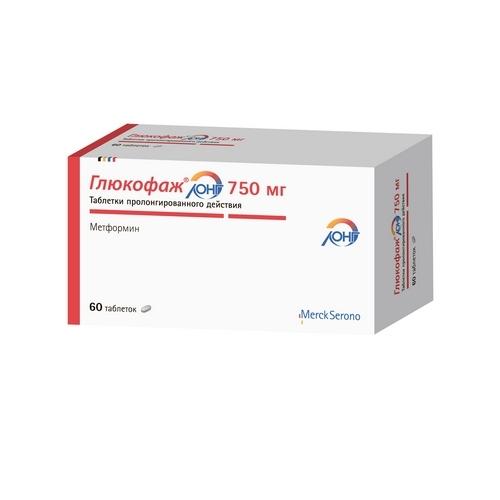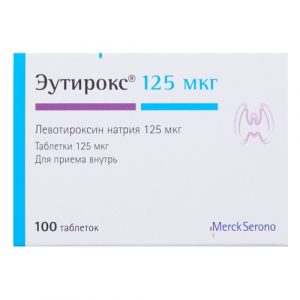Description
Latin name
Glucophage long
Release form
Sustained-release tablets.
packaging 60 pcs
Pharmacological action
Oral hypoglycemic preparation from the biguanide group, which reduces as basal, and postprandial plasma glucose. It does not stimulate insulin secretion and therefore does not cause hypoglycemia. Increases the sensitivity of peripheral receptors to insulin and the utilization of glucose by cells. Reduces liver glucose production by inhibiting gluconeogenesis and glycogenolysis. Delays intestinal absorption of glucose.
Metformin stimulates glycogen synthesis by acting on glycogen synthetase. Increases transport capacity of all types of membrane glucose transporters.
Indications
Treatment of type 2 diabetes in adults with dietotherapy and exercise stress (especially in patients with obesity):
As monotherapy.
In combination with other oral hypoglycemic drugs, or in combination with insulin.
Contraindications
Diabetic ketoacidosis, diabetic precoma, coma.
Renal failure or impaired renal function (CC less than 60 ml / min).
Acute conditions with a risk of developing renal dysfunction, including dehydration (with diarrhea, vomiting), severe infectious diseases, shock.
Clinically expressed manifestations of acute and chronic diseases that can lead to the development of tissue hypoxia (including heart or respiratory failure, acute myocardial infarction).
Extensive surgery and injury when insulin therapy is indicated.
Hepatic failure, impaired liver function.
Chronic alcoholism, acute alcohol poisoning.
Lactic acidosis (including history).
Use for at least 48 hours before and within 48 hours after conducting radioisotope or x-ray studies with the introduction of iodine-containing contrast medium.
Compliance with a low-calorie diet (less than 1000 kcal / day).
Pregnancy.
Lactation (breastfeeding).
Age to 18 years.
Hypersensitivity to the drug.
Caution: the drug should be used in patients older than 60 years who perform heavy physical work, which is associated with an increased risk of developing lactic acidosis in them.
Use during pregnancy and lactation
When planning a pregnancy, and also in case of pregnancy on the background of taking the drug Glucofage Long, the drug should be discontinued to prescribe insulin therapy. The patient should inform the doctor about the onset of pregnancy while taking Glucofage Long.
Metformin is excreted in breast milk. Side effects in newborns during breastfeeding while taking metformin were not observed. However, due to the limited amount of data, the use of the drug during breastfeeding is not recommended.
Composition
1 tablet contains:
Active ingredient: metformin hydrochloride – 750 mg.
Excipients: carmellose sodium – 37.5 mg, hypromellose 2208 – 294.24 mg, magnesium stearate – 5.3 mg.
Dosage and administration of
The drug is taken during dinner (1 time / day).
Monotherapy and combination therapy in combination with other hypoglycemic agents
The initial dose is usually 1 tab. 1 time / day
After 10-15 days of treatment, the dose must be adjusted based on the results of measuring blood glucose concentration. Slow increase in dose helps to reduce side effects from the gastrointestinal tract.
The recommended dose of the drug is 1.5 g (2 tablets) 1 time / day. If, while taking the recommended dose, it is not possible to achieve adequate glycemic control, it is possible to increase the dose to a maximum of 2.25 g (3 tablets) 1 time / day.
If adequate glycemic control is not achieved with 3 tablets. 750 mg 1 time / day, it is possible to switch to a metformin preparation with the usual release of the active substance with a maximum daily dose of 3 g.
For patients already receiving treatment with metformin tablets, the initial dose of Glucofage Long should be equivalent to the daily dose of the tablets with the usual release. Patients taking metformin in the form of tablets with a usual release in a dose exceeding 2 g are not recommended to switch to Glucofage Long.
If you plan to switch from another hypoglycemic agent: you must stop taking another drug and start taking Glucofage Long at the dose indicated above.
Combination with insulin
To achieve better control of blood glucose concentrations, metformin and insulin can be used as a combination therapy. The usual initial dose of Glucofage Long is 1 tab. 750 mg 1 time / day during dinner, while the dose of insulin is selected based on the measurement of glucose in the blood.
Special patient groups
In elderly patients and patients with reduced renal function, the dose is adjusted based on an assessment of renal function, which must be performed regularly at least 2 times a year.
Glucofage Long should not be used in children and adolescents under 18 years of age due to lack of data on the use.
Side effects
Determination of the frequency of side effects:
Very often ( 1/10).
Often ( 1/100, <1/10). Infrequently ( 1/1000, <1/100). Rarely ( 1/10 000, <1/1000). Very rarely (<1/10 000), single - cannot be evaluated with the available data. Side effects are presented in decreasing order of importance. From the side of the nervous system: often – taste disturbance (metallic taste in the mouth). From the digestive system: very often – nausea, vomiting, diarrhea, abdominal pain, lack of appetite. Most often they occur in the initial period of treatment and in most cases pass spontaneously. To prevent symptoms, it is recommended that you take metformin with meals. Slow dose increases can improve gastrointestinal tolerance. From the skin: very rarely – erythema, itching, urticaria. From the side of metabolism: very rarely – lactic acidosis. With prolonged use of metformin, a decrease in the absorption of vitamin B12 is possible, accompanied by a decrease in its concentration in the blood serum. If megaloblastic anemia is detected, the possibility of such an etiology must be considered. From the hepatobiliary system: there are few reports of impaired liver function or hepatitis after the withdrawal of metformin, adverse events completely disappear. If dyspeptic symptoms do not disappear, treatment with metformin should be discontinued. Drug Interaction Contraindications combinations On the background of functional renal failure in patients with diabetes, radiological examination using iodine-containing contrast agents may cause the development of lactic acidosis. Long glucose should be discontinued 48 hours before and should not be resumed earlier than 2 days after radiological examination using iodine-containing contrast media, provided that renal function was recognized as normal during the examination. Recommended combinations Ethanol intake increases the risk of lactic acidosis during acute alcohol intoxication, especially in the case of malnutrition, low-calorie diets, and hepatic insufficiency. Ethanol-containing drugs should not be used during treatment. Combinations with caution Drugs with indirect hyperglycemic action (eg, ACS and tetracosactide for systemic and topical use, beta2-adrenomimetics, danazol, chlorpromazine at high doses (100 mg / day) and may be diuretic: blood glucose concentrations, especially at the beginning of treatment. If necessary, the dose of the drug Glucophage Long can be adjusted during treatment and after its termination, based on the level of glycemia. Concurrent intake of loop diuretics may lead to the development of lactic acidosis due to possible functional renal failure. Do not prescribe Long Glucose if the QC is less than 60 ml / min. ACE inhibitors can reduce blood glucose. Metformin dose should be adjusted as necessary. With the simultaneous use of the drug Glucophage Long with derivatives of sulfonylurea, insulin, acarbose, salicylates may develop hypoglycemia. Nifedipine increases the absorption and Cmax of metformin. Cationic drugs (amiloride, digoxin, morphine, procainamide, quinidine, quinine, ranitidine, triamterene, trimethoprim and vancomycin) secreted in the renal tubules compete with metformin for tubular transport systems and may increase its Cmax. Increased blood glucose monitoring may be required when administered with the above medicines, especially at the beginning of treatment. If necessary, the dose of metformin can be adjusted during treatment and after discontinuation. overdose Symptoms: no hypoglycemia was observed with the use of metformin at a dose of 85 g (42.5 times the maximum daily dose), but in this case the development of lactic acidosis was observed. Significant overdose or associated risk factors can lead to the development of lactic acidosis. Treatment: in the event of signs of lactic acidosis, the drug should be stopped immediately, the patient urgently hospitalized and, having determined the concentration of lactate, to clarify the diagnosis. Hemodialysis is the most effective measure to eliminate lactate and metformin. Symptomatic treatment is also carried out. Storage conditions Keep out of the reach of children at a temperature not exceeding 25 ° C. The Expiration of is 3 years. Deystvuyuschee substances Metformin




